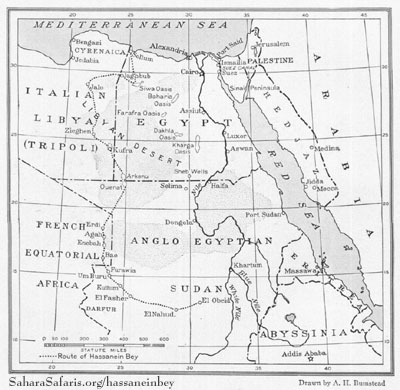
























|
THE SENUSSI, A SECT, NOT A PEOPLE
The reader sees always connected
with the Libyan Desert the word
Senussi. Many people think the
Senussi are a tribe or a people. In reality, they are a sect of the
Moslem religion embracing all the tribes of
Cyrenaica and having
influence in North Africa and the region south of Kufra. It is a
comparatively recent sect, being only about 80 years old.
Its founder, Sidi Mohammed Ibn
Ali El Senussi, came from Algeria about 100 years ago. On his long
journey to Mecca he saw that there is a fertile field for his teachings
in Tripoli and Cyrenaica. He established the famous University of Jaghbub (see page 238) and preached a very primitive and pure form of
Islam, shorn of all luxuries. The devotees were not even allowed to
drink coffee or smoke, and up to ten years ago the man caught smoking
was severely punished, sometimes to the extent of having one of his
hands cut off.
It has been said by explorers
that the tribes of Cyrenaica, who are all under Senussi influence, are
actuated by religious fanaticism when they refuse foreigners permission
to enter their territory. To my great interest, however, I discovered
that not religious, but patriotic, fervor is the impelling principle.
Their reasoning is simple. They do not want any aliens to come into
(p234) [photo]
(p235) the country, for they say foreigners
mean domination, domination means paying taxes, and they do not want to
pay taxes! Therefore, the best way to avoid taxes is to prevent any
stranger from entering the region.

Stone houses
of siwa, one of the most historic oases of northerN africa
the lofty structures indicate
that Siwa was at one time a point of defense from desert tribes. In the
middle distance, slightly to the right, is the covered market-place.
Siwa was noted for its Temple of Ammon even before the time of
Herodotus, and Alexander the Great came here to consult the oracle.
[photo page 235]

A
sketch map showing the route of Hassanein Bey through the Libyan desert
The results of the author's
journey include the determination of the exact positions of the wells of
Zieghen and the Oasis of Kufra, resulting in changes of 62 and 24 miles
respectively from the positions hitherto assigned to these places on
maps of Africa; the discovery of the oases of Arkenu and Ouenat,
previously unknown; the discovery of a route from southwestern Egypt
across the Erdi Plateau of French Equatorial Africa into Darfur, and the
determination of elevations along the entire route. [photo page 236]
Now, who are the outsiders who
come to their country? They are European explorers — Christians.
Therefore, no Christians are permitted to enter. Explorers had been
forbidden to go into the interior, and with the exception of the German
scientist Rohlfs, who in 1879 boldly ventured to Kufra but escaped with
little more than his life, this prohibition had been effective. But when
I, a Moslem, the son of a religious man and a friend of their head man,
arrived, they scratched their heads. Here was a foreigner whom they did
not want, but they could not convict him on religious grounds. I had to
be tolerated, temporarily at any rate.
My first objective from Sollum
was
(p236) Siwa, where I arrived after a nine days
trek. This is one of the oldest oases of the Libyan Desert, and the most
prosperous because of its date trees and its numerous springs. Its
geographical position has made it a center for
Bedouins trading between Egypt and the interior of Cyrenaica.

the armed men
of the caravan
Hassanein Bey is mounted upon his
Arab horse Baraka (see text, page 245). [photo page 237]

|
